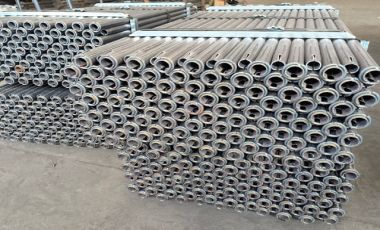
Anchor bolt support refers to a reinforcement and support method used in the construction of underground caverns such as slopes, deep foundation pits, tunnels, stopes, etc. The rods made of metal, wood, polymer or other materials are driven into the surface rock mass or pre-drilled holes in the rock mass around the chamber, and the special structure of the head and rod body and the support of the tail are used. Plate (can not be used), or rely on the bonding effect to produce suspension effect, composite beam effect and reinforcement effect, so that the surrounding rock can be combined with the stable rock mass to achieve the purpose of support.
The split set bolt support is generally combined with the permanent support of shotcrete, and the function of the bolt is mainly composite beam; in the construction of semi-coal rock roadway, the bolt support generally plays the role of hanging rock, and must be matched with the sticking of the coal seam and the corresponding backing. Column and other support measures.
The split set bolt is a tubular rod that is rolled with a high-strength metal plate to form a longitudinal seam, and a hole smaller than the diameter of the rod is forcibly pressed with a rock drill (the fit difference is 2~3mm). It can immediately exert radial pressure on the hole wall within the range of 80~100cm along the hole, generate friction to prevent the surrounding rock from sliding down, and add the bearing capacity of the anchor plate, so that the surrounding rock is in a three-dimensional stress state, and the elastic tension of the pipe wall is realized. The friction anchoring force generated by the pressure hole wall is to actively reinforce the layers like expansion nails.
The developed rock formation is firmly nailed into the surrounding stable rock formation, and the extrusion force of the bolt on the borehole is about 25kN per meter, and the generated anchoring force is roughly equal to the extrusion force. The thicker the pipe wall, the higher the elastic stress of the metal pipe. The smaller the aperture compression, the greater the anchoring force. Its anchoring force in hard rock formations is large, for example, the anchoring force in sandstone can reach 60~100kn. During the anchoring movement of surrounding rock caused by blasting vibration or with the passage of time, the later anchoring force has a tendency to increase significantly. After 100 days of installation in coal measures, the anchoring force can be increased from 60kN to 90kN. It has better adaptability to the lateral displacement of the formation; the borehole becomes curved and the anchorage becomes firmer.Address: No. 1738, 17th Floor, No. 1 Mall, Shangdu Road, Zhengdong New District, Zhengzhou City, Henan Province, China
Email: zxminesupport@zxsteelgroup.com
Tel: +86-199 3712 3680
© 2020 ZXSTEELGROUP